load capacity AUDI A7 2021 Owner´s Manual
[x] Cancel search | Manufacturer: AUDI, Model Year: 2021, Model line: A7, Model: AUDI A7 2021Pages: 350, PDF Size: 126.66 MB
Page 137 of 350

4K8012721BF
Trailer towing
Trailer towing
Driving with a trailer
eT e e eeu)
Your vehicle is primarily intended for transport-
ing people and luggage. However, if you drive
with a trailer, follow the technical requirements,
the operation and driving tips, and the legal reg-
ulations.
Driving with a trailer affects the vehicle's energy
usage, performance, and wear. It also requires
higher concentration from the driver.
Z\ WARNING
Do not transport any people in a trailer due to
the risk of fatal injury.
Technical requirements
Trailer hitch
Only use a trailer hitch with a removable ball
hitch mount and ball hitch. The trailer hitch must
be permitted for the vehicle, the trailer and the
permitted total weight of the trailer being
pulled. Above all, it must be securely and safely
attached to the vehicle trailer.
Never mount a trailer hitch on the bumper. The
trailer hitch must be mounted in a way that does
not impair the function of the bumper. Do not
make any changes to the exhaust system and the
brake system.
Check regularly if the trailer hitch is securely
mounted. Always follow the instructions given by
the trailer hitch manufacturer.
Trailer brakes
If the trailer has its own brake system, then fol-
low the manufacturer specifications. However,
the brake system on the trailer must never be
connected to the vehicle brake system.
Engine cooling system
Driving with a trailer means a higher load on the
engine and the cooling system. The cooling sys-
tem must be designed for additional load and
contain enough coolant > @®.
CG) Note
Longer inclines cannot be driven without a
suitable cooling system, especially if the out-
side temperatures are high. Otherwise, this
increases the risk of engine damage.
Operating instructions
Towing capacity
Your vehicle can only be operated with class 1 or
class 2 trailers.
Load distribution
Poor cargo load and distribution can negatively
impact vehicle handling. Load the trailer based
on the following criteria as much as possible:
— Store objects in the vehicle luggage compart-
ment, if possible. The vehicle should always
carry the heaviest possible load and the trailer
should have the lightest possible load.
— Distribute the load in the trailer so that the
heavy objects are as close to the axle as possi-
ble.
— Secure objects so that they do not slide.
— Utilize the maximum permitted tongue weight
if possible.
Tires
Set the tire pressure on your vehicle for a “full
load”; see the tire pressure sticker > page 284. If
necessary, also adjust the tire pressure on the
trailer according to the manufacturer's specifica-
tions.
The trailer and the vehicle should be equipped
with winter tires when driving in winter tempera-
tures.
Outside mirrors
If you cannot see the traffic behind the trailer
with the standard exterior mirrors, then you
must attach additional exterior mirrors. Adjust
them so you have a sufficient visibility behind
you.
Exterior lighting
Follow the legal regulations for lighting on your
trailer that are applicable in the country where
135
>
Page 246 of 350

Media
Online additional data
Requirement: the MMI must be connected to the
Internet. A data plan must be available
=> page 212.
When the function is switched on, additional in-
formation (such as album cover, artist, track) will
be loaded depending on the availability from the
different providers.
DVD playback parental cntrl.
Playback of video DVDs can be restricted based
on age restrictions using parental control.
Displaying the DVD parental control menu
> Applies to: MMI: Select on the home screen:
MEDIA > % > DVD playback control.
> Enter the PIN for parental control. The PIN set
at the factory is 1234.
> Press OK.
Switching the rating level on and off
Requirement: the DVD parental control menu
must be displayed.
> Select: DVD playback parental cntrl. > a rating
level (for example, level 5) > *, or
> To remove all restrictions, press Off.
Eight different protection levels can be set for
parental control. If you set the parental control
level at level 5, all DVDs from levels 1 - 5 can be
played. Video DVDs with a higher level will not
play.
Changing the PIN
Requirement: the DVD parental control menu
must be displayed.
> Select: Change PIN > enter a new PIN for pa-
rental control > OK.
> Repeat the entry and press OK.
G) Tips
— Not all video DVDs have parental control.
— The protection levels for the parental con-
trol are based on the US standards from the
Motion Picture Association of America
(MPAA). Note that the age levels for video
DVDs in European countries may differ.
— PIN entry for parental control will be locked
for approximately one minute if you enter
the incorrect PIN three times in a row. The
PIN can only be reset by an authorized Audi
dealer.
Supported media and file formats
LO ra TN]
Depending on the vehicle equipment, the follow-
ing properties for media files may be supported
by the DVD drive and the connection for USB stor-
age devices:
Audio/video files
DVD drive: audio CDs (up to 80 min) with CD text (artist, album,
Supported media
song)*, CD-ROMs with a capacity of up to 700 MB; DVD+R/RW; DVD
video; DVD audio with audio tracks that are compatible with a DVD
video player;
Audi music interface: mobile devices > page 238 (such as an iPhone,
MTP player, USB storage device in “USB Device Subclass 1 and 6” that
conforms to USB 2.0: USB sticks, USB MP3 players (Plug-and-Play-ca-
pable), external USB flash drives and hard drives
File system
USB storage device: exFAT, FAT, FAT32, NTFS
USB storage device partitions (primary/logical*): 2 per USB connec-
tion
CD/DVD file systems: ISO9660, Joliet, UDF
244
Page 277 of 350

4K8012721BF
Wheels
Tire designations
B8K-2316
Fig. 170 Tire designations on the side-
wall
@ Tires for passenger vehicles
(if applicable)
“P” indicates a tire for a passen-
ger vehicle. “T” indicates a tire
designated for temporary use.
@ Nominal width
Nominal width of the tire be-
tween the sidewalls in millime-
ters. In general: the larger the
number, the wider the tire.
@) Aspect ratio
Height/width ratio expressed as a
percentage.
@ Tire construction
“R” indicates a radial tire.
©) Rim diameter
Size of the rim diameter in inches.
© Load index and speed rating
The load index indicates the tire's
load-carrying capacity.
The speed rating indicates the
maximum permitted speed. Also
see > A in General information on
page 274.
“EXTRA LOAD”, “xl” or “RF” indi-
cates that the tire is reinforced or
is an Extra Load tire.
Speed rat- /Maximum permitted speed
ing
P up to 93 mph (150 km/h)
Q up to 99 mph (160 km/h)
R up to 106 mph (170 km/h)
S up to 110 mph (180 km/h)
T up to 118 mph (190 km/h)
U up to 124 mph (200 km/h)
H up to 130 mph (210 km/h)
Vv up to 149 mph (240 km/h)?
Zz above 149 mph (240 km/h)?)
w up to 168 mph (270 km/h)?
y up to 186 mph (300 km/h)?
a) For tires above 149 mph (240 km/h),
tire manufacturers sometimes use the
code “ZR”.
275
Page 279 of 350
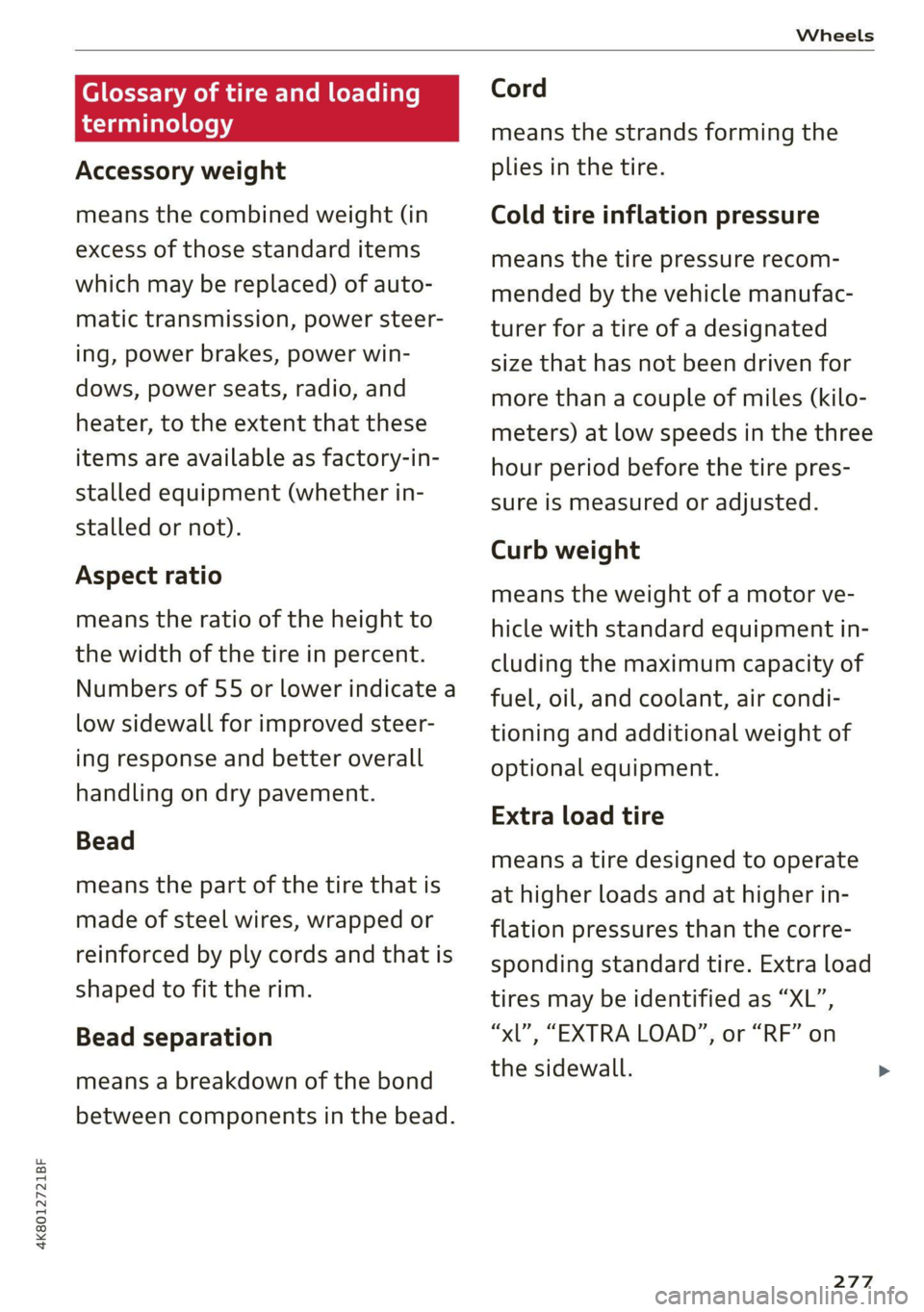
4K8012721BF
Wheels
Glossary of tire and loading
terminology
Accessory weight
means the combined weight (in
excess of those standard items
which may be replaced) of auto-
matic transmission, power steer-
ing, power brakes, power win-
dows, power seats, radio, and
heater, to the extent that these
items are available as factory-in-
stalled equipment (whether in-
stalled or not).
Aspect ratio
means the ratio of the height to
the width of the tire in percent.
Numbers of 55 or lower indicate a
low sidewall for improved steer-
ing response and better overall
handling on dry pavement.
Bead
means the part of the tire that is
made of steel wires, wrapped or
reinforced by ply cords and that is
shaped to fit the rim.
Bead separation
means a breakdown of the bond
between components in the bead.
Cord
means the strands forming the
plies in the tire.
Cold tire inflation pressure
means the tire pressure recom-
mended by the vehicle manufac-
turer for a tire of a designated
size that has not been driven for
more than a couple of miles (kilo-
meters) at low speeds in the three
hour period before the tire pres-
sure is measured or adjusted.
Curb weight
means the weight of a motor ve-
hicle with standard equipment in-
cluding the maximum capacity of
fuel, oil, and coolant, air condi-
tioning and additional weight of
optional equipment.
Extra load tire
means a tire designed to operate
at higher loads and at higher in-
flation pressures than the corre-
sponding standard tire. Extra load
tires may be identified as “XL”,
“xl”, “EXTRA LOAD”, or “RF” on
the sidewall.
277
Page 280 of 350
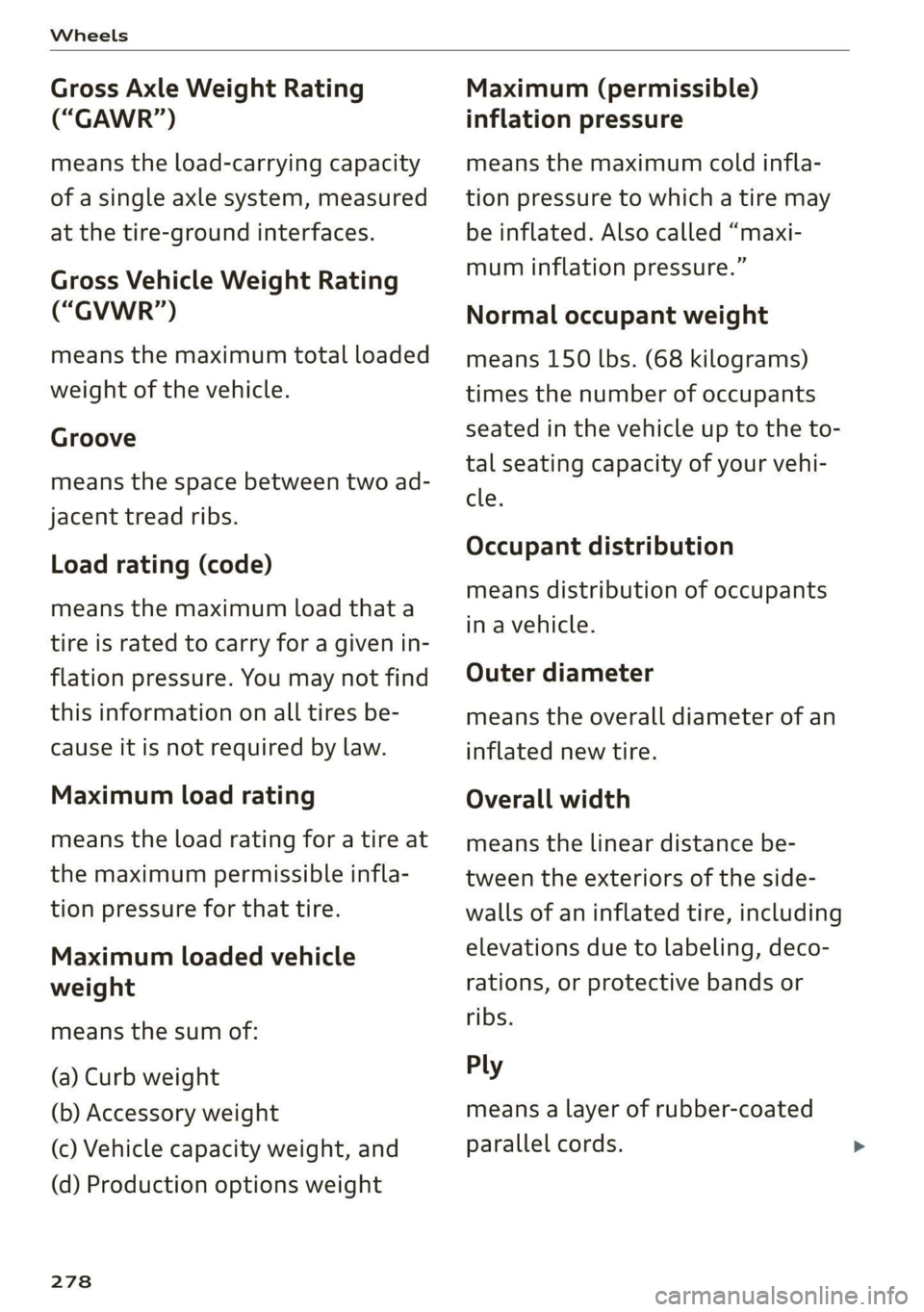
Wheels
Gross Axle Weight Rating
(“GAWR’”)
means the load-carrying capacity
of a single axle system, measured
at the tire-ground interfaces.
Gross Vehicle Weight Rating
(“GVWR”)
means the maximum total loaded
weight of the vehicle.
Groove
means the space between two ad-
jacent tread ribs.
Load rating (code)
means the maximum load that a
tire is rated to carry for a given in-
flation pressure. You may not find
this information on all tires be-
cause it is not required by law.
Maximum load rating
means the load rating for a tire at
the maximum permissible infla-
tion pressure for that tire.
Maximum loaded vehicle
weight
means the sum of:
(a) Curb weight
(b) Accessory weight
(c) Vehicle capacity weight, and
(d) Production options weight
278
Maximum (permissible)
inflation pressure
means the maximum cold infla-
tion pressure to which a tire may
be inflated. Also called “maxi-
mum inflation pressure.”
Normal occupant weight
means 150 lbs. (68 kilograms)
times the number of occupants
seated in the vehicle up to the to-
tal seating capacity of your vehi-
cle.
Occupant distribution
means distribution of occupants
in a vehicle.
Outer diameter
means the overall diameter of an
inflated new tire.
Overall width
means the linear distance be-
tween the exteriors of the side-
walls of an inflated tire, including
elevations due to labeling, deco-
rations, or protective bands or
ribs.
Ply
means a layer of rubber-coated
parallel cords.
Page 283 of 350
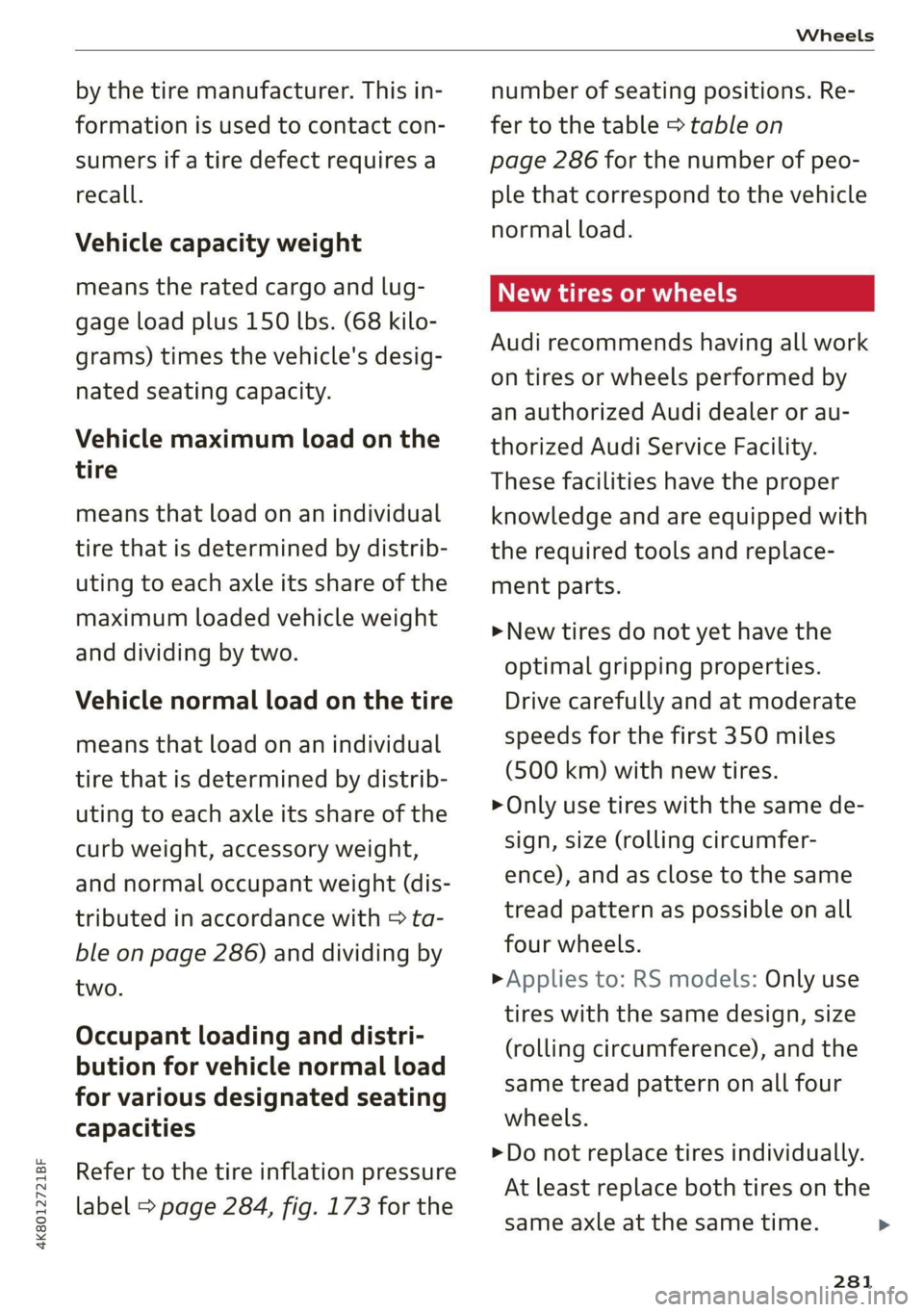
4K8012721BF
Wheels
by the tire manufacturer. This in-
formation is used to contact con-
sumers if a tire defect requires a
recall.
Vehicle capacity weight
means the rated cargo and lug-
gage load plus 150 lbs. (68 kilo-
grams) times the vehicle's desig-
nated seating capacity.
Vehicle maximum load on the
tire
means that load on an individual
tire that is determined by distrib-
uting to each axle its share of the
maximum loaded vehicle weight
and dividing by two.
Vehicle normal load on the tire
means that load on an individual
tire that is determined by distrib-
uting to each axle its share of the
curb weight, accessory weight,
and normal occupant weight (dis-
tributed in accordance with > ta-
ble on page 286) and dividing by
two.
Occupant loading and distri-
bution for vehicle normal load
for various designated seating
capacities
Refer to the tire inflation pressure
label > page 284, fig. 173 for the
number of seating positions. Re-
fer to the table > table on
page 286 for the number of peo-
ple that correspond to the vehicle
normal load.
New tires or wheels
Audi recommends having all work
on tires or wheels performed by
an authorized Audi dealer or au-
thorized Audi Service Facility.
These facilities have the proper
knowledge and are equipped with
the required tools and replace-
ment parts.
>New tires do not yet have the
optimal gripping properties.
Drive carefully and at moderate
speeds for the first 350 miles
(500 km) with new tires.
> Only use tires with the same de-
sign, size (rolling circumfer-
ence), and as close to the same
tread pattern as possible on all
four wheels.
> Applies to: RS models: Only use
tires with the same design, size
(rolling circumference), and the
same tread pattern on all four
wheels.
>Do not replace tires individually.
At least replace both tires on the
same axle at the same time.
281
>
Page 290 of 350
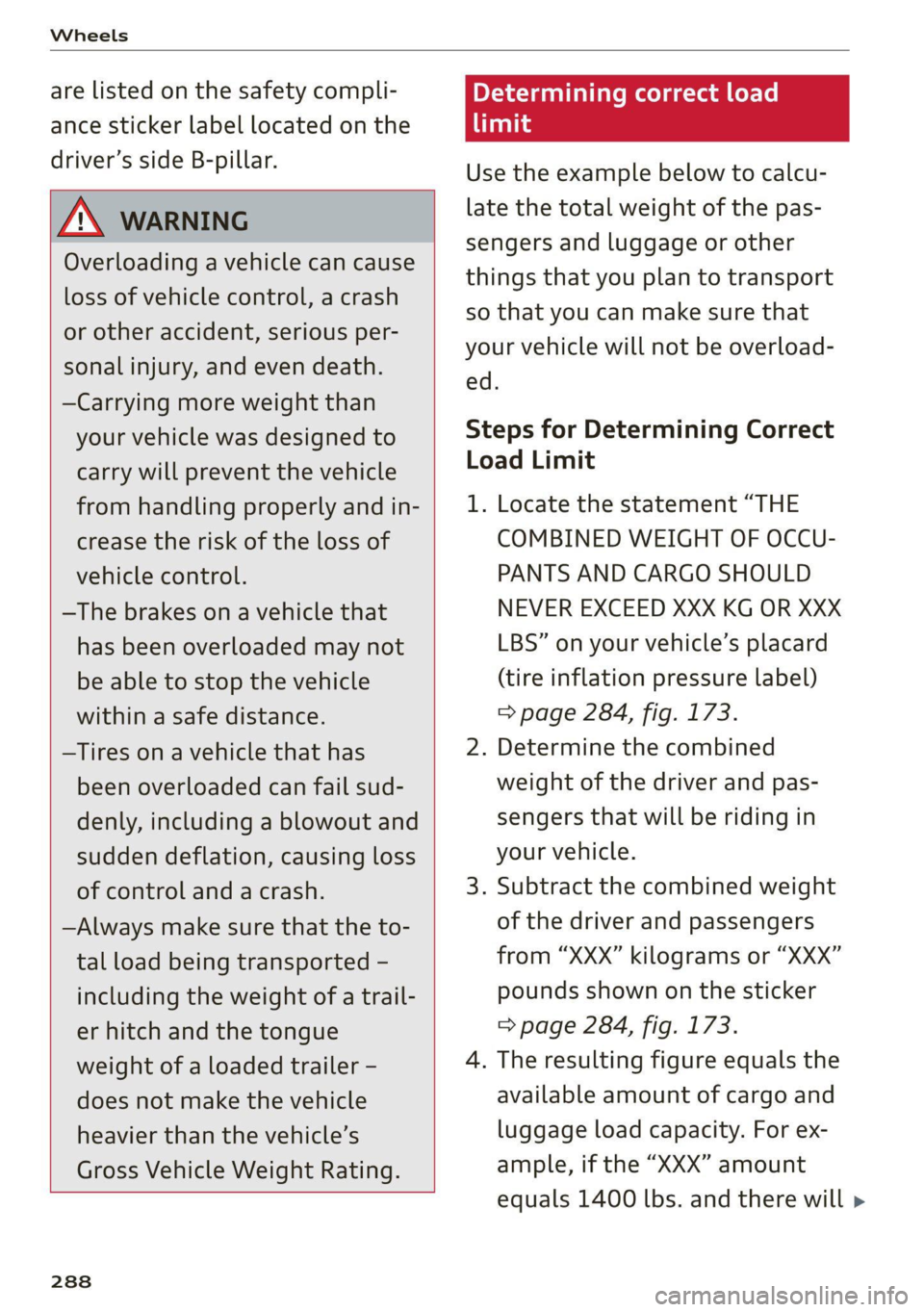
Wheels
are listed on the safety compli-
ance sticker label located on the
driver’s side B-pillar.
TN WARNING
Overloading a vehicle can cause
loss of vehicle control, a crash
or other accident, serious per-
sonal injury, and even death.
—Carrying more weight than
your vehicle was designed to
carry will prevent the vehicle
from handling properly and in-
crease the risk of the loss of
vehicle control.
—The brakes on a vehicle that
has been overloaded may not
be able to stop the vehicle
within a safe distance.
—Tires on a vehicle that has
been overloaded can fail sud-
denly, including a blowout and
sudden deflation, causing loss
of control and a crash.
—Always make sure that the to-
tal load being transported -
including the weight of a trail-
er hitch and the tongue
weight of a loaded trailer -
does not make the vehicle
heavier than the vehicle’s
Gross Vehicle Weight Rating.
288
Determining correct load
Talis
Use the example below to calcu-
late the total weight of the pas-
sengers and luggage or other
things that you plan to transport
so that you can make sure that
your vehicle will not be overload-
ed.
Steps for Determining Correct
Load Limit
1. Locate the statement “THE
COMBINED WEIGHT OF OCCU-
PANTS AND CARGO SHOULD
NEVER EXCEED XXX KG OR XXX
LBS” on your vehicle’s placard
(tire inflation pressure label)
> page 284, fig. 173.
2. Determine the combined
weight of the driver and pas-
sengers that will be riding in
your vehicle.
3. Subtract the combined weight
of the driver and passengers
from “XXX” kilograms or “XXX”
pounds shown on the sticker
=> page 284, fig. 173.
4. The resulting figure equals the
available amount of cargo and
luggage load capacity. For ex-
ample, if the “XXX” amount
equals 1400 lbs. and there will >
Page 291 of 350

4K8012721BF
Wheels
be five 150 lbs. passengers in
your vehicle, the amount of
available cargo and luggage
load capacity is 650 lbs.
(1400-750 (5 x 150) = 650
lbs.)
5. Determine the combined
weight of luggage and cargo
being loaded on the vehicle.
That weight may not safely ex-
ceed the available cargo and
luggage load capacity calculat-
ed in Step 4.
6. If your vehicle will be towing a
trailer, load from your trailer
will be transferred to your vehi-
cle. Consult this manual to de-
termine how this reduces the
available cargo and luggage
load capacity of your vehicle.
> Check the tire sidewall
(> page 275, fig. 170) to deter-
mine the designated load rating
for a specific tire.
Wheel bolts and rims
Wheel bolts
Wheel bolts must be clean and loosen/tighten
easily.
Rims
Rims with a bolted rim ring* or with bolted wheel
covers* consist of multiple pieces. These compo-
nents were bolted together using special bolts
and a special procedure. You must not repair or
disassemble them > A\.
ZA\ WARNING
Wheel bolts that are tightened or repaired in-
correctly can become loose and result in loss
of vehicle control, which increases the risk of
an accident. For the correct tightening specifi-
cation, see > page 311, Finishing.
— Always keep the wheel bolts and the threads
in the wheel hub clean and free of grease.
— Only use wheel bolts that fit the rim.
— Always have damaged rims repaired by an
authorized Audi dealer or authorized Audi
Service Facility. Never repair or disassemble
rims yourself, because this increases the risk
of an accident.
Loose wheel warning
Applies to: vehicles with loose wheel warning
Within the limits of the system, the loose wheel
warning in the instrument cluster warns you if
one or more wheels are loose.
Using the ABS sensors, the loose wheel warning
system compares the vibration characteristics of
the individual tires. If one or more wheels are
loose, it will be indicated in the instrument clus-
ter display with the fi indicator light and a mes-
sage. If only one wheel is affected, the location
of that wheel will be indicated.
Messages
fi Wheel bolts loose. Please safely stop the ve-
hicle and check all wheel bolts!
Loose wheel warning for at least one wheel > A\.
Check the wheel bolts on all wheels with the
wheel wrench (vehicle tool kit). Have the tighten-
ing specification checked as soon as possible with
a torque wrench. Drive carefully until then. For
the correct tightening specification, see
=> page 311, Finishing.
fi Wheel assessment active. Please continue
driving carefully
After this message appears and you have checked
the wheel bolts, the assessment phase begins
when the vehicle is in motion. This may take sev-
eral minutes. >
289
Page 339 of 350
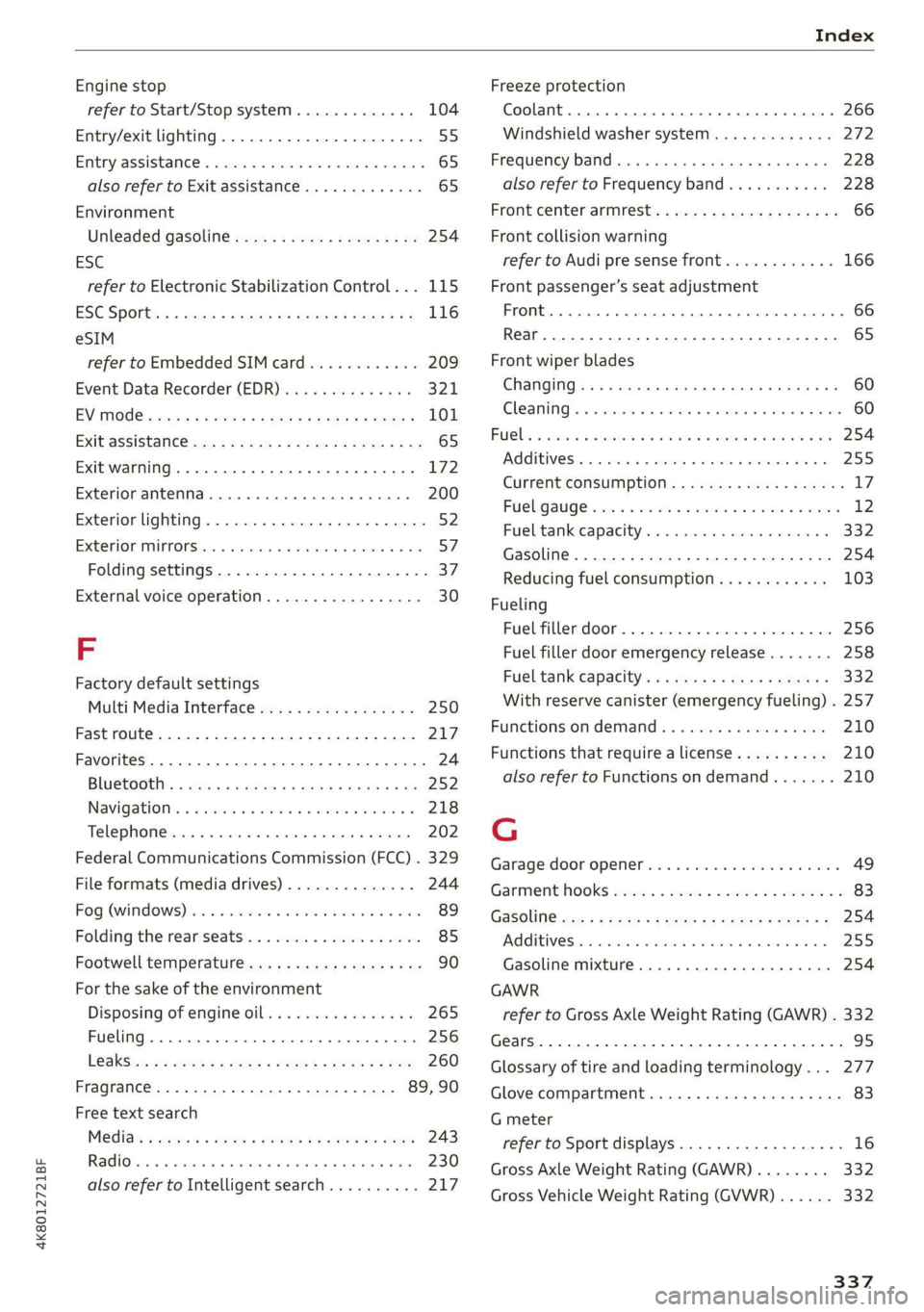
4K8012721BF
Index
Engine stop
refer to Start/Stop system............. 104
Entry/exit lighting..............02-.000- 55
Entryzassistanee «ecco © euessa o © wneuniss * 6 sonnets 65
also refer to Exit assistance............. 65
Environment
Unleaded gasoline..................0. 254
ESC
refer to Electronic Stabilization Control... 115
ES@:SPOMrts: « 2 zoam = + aoe = x eee ee eee a ee 116
eSIM
refer to Embedded SIM card............ 209
Event Data Recorder (EDR).............. 321
EV MOd6 « snes s gene x ¢ ewe & s BORE ee Hew F 101
Exitassistani@@isus « = wsme » ¢ mews sy eee x = oe 65
Exitwarning..............0..0.00.0005 172
Exterior antenna...............0..0-0. 200
Exterior lighting.................02--00 52
EXteniOrMiRMOrSices « « soxzase » © egwiene » @ aguiore 9 «one 57
Folding settings...............-.000005 37
External voice operation................. 30
F
Factory default settings
Multi Media Interface................. 250
Fast route............... 0.00.00 .0 00 217
Favorites... 0.2.0... eee eee eee ee eee 24
BLUSEOOEH « & wwe = ¢ meme < & eee < Rae 7 pe 252
Navigation: « x sscses we sarees ¥ a senusns oo seein 3 218
Telephone
Federal Communications Commission (FCC) . 329
File formats (media drives).............. 244
Fog QWINdOWS) ais i & socusie vs awccims ve suave 6 w one 89
Folding the rearseats................00. 85
Footwell temperature.............0.0005 90
For the sake of the environment
Disposing of engine oil................ 265
Fueling... 0.2... 0. cece eee eee eee 256
L@AKSicx: = = meme co Seis e REE E ¢ BemeE es os 260
Fragrance............0-. eee eee eee 89, 90
Free text search
Média « = esas « © sees + = sews te ews sv ews 243
Radi Obsis os ssciwire ae easewie aw anseans «waren 6H a 230
also refer to Intelligent search.......... 217
Freeze protection
Coolant... .. ee eee eee eee 266
Windshield washer system............. 272
Frequency band ..........-eseceeeeeeee 228
also refer to Frequency band........... 228
Front. center armrest. . ness ss sees s aces ce 66
Front collision warning
refer to Audi pre sense front............ 166
Front passenger’s seat adjustment
FROME. « «ensue v0 anes + 0 veers w ananaite a 0) anance « 66
Rear... eee eee 65
Front wiper blades
Changing « 2 same « z asm = neem 2 a Rem BEE 60
Cleaning’. « « soci vo soecen +o sveneue eo wees © a ave 60
BUCles & sours
Additives ...... 0... cece eee eee 25S
CUPFENCCONSUMIPLION,» sess s ¢ eaves s 7 sanes ¢ 17
FUCL Gales «x meen a eae sa ewe se ee 12
Fuel tank capacity.............-.000005 332
Gasoline. 1.1.0... cee eee ee 254
Reducing fuel consumption............ 103
Fueling
FuelFillersdoor in: = saver 2 wevers to x sucess ao a0 256
Fuel filler door emergency release....... 258
Fuel tank capacity.............-.0 eee 332
With reserve canister (emergency fueling) . 257
Functions on demand...............0.. 210
Functions that require a license.......... 210
also refer to Functions on demand....... 210
G
Garage door opener............-.000000- 49
GarmMentihOOks scesiie sv cevevce « x sscwese 2 a wees 9 0 3 83
GaSOlIMG oy « x seseye g = eee = 2 eee 4 ¢ see & 254
Additives... 2.0... ccc eee eee 255
Gasoline mixture ...............000 eee 254
GAWR
refer to Gross Axle Weight Rating (GAWR) . 332
Gears... ee eee eee 95
Glossary of tire and loading terminology... 277
Glove compartment.............-00e eee 83
G meter
refer to Sport displays.................. 16
Gross Axle Weight Rating (GAWR)........ 332
Gross Vehicle Weight Rating (GVWR)...... 332
337
Page 348 of 350
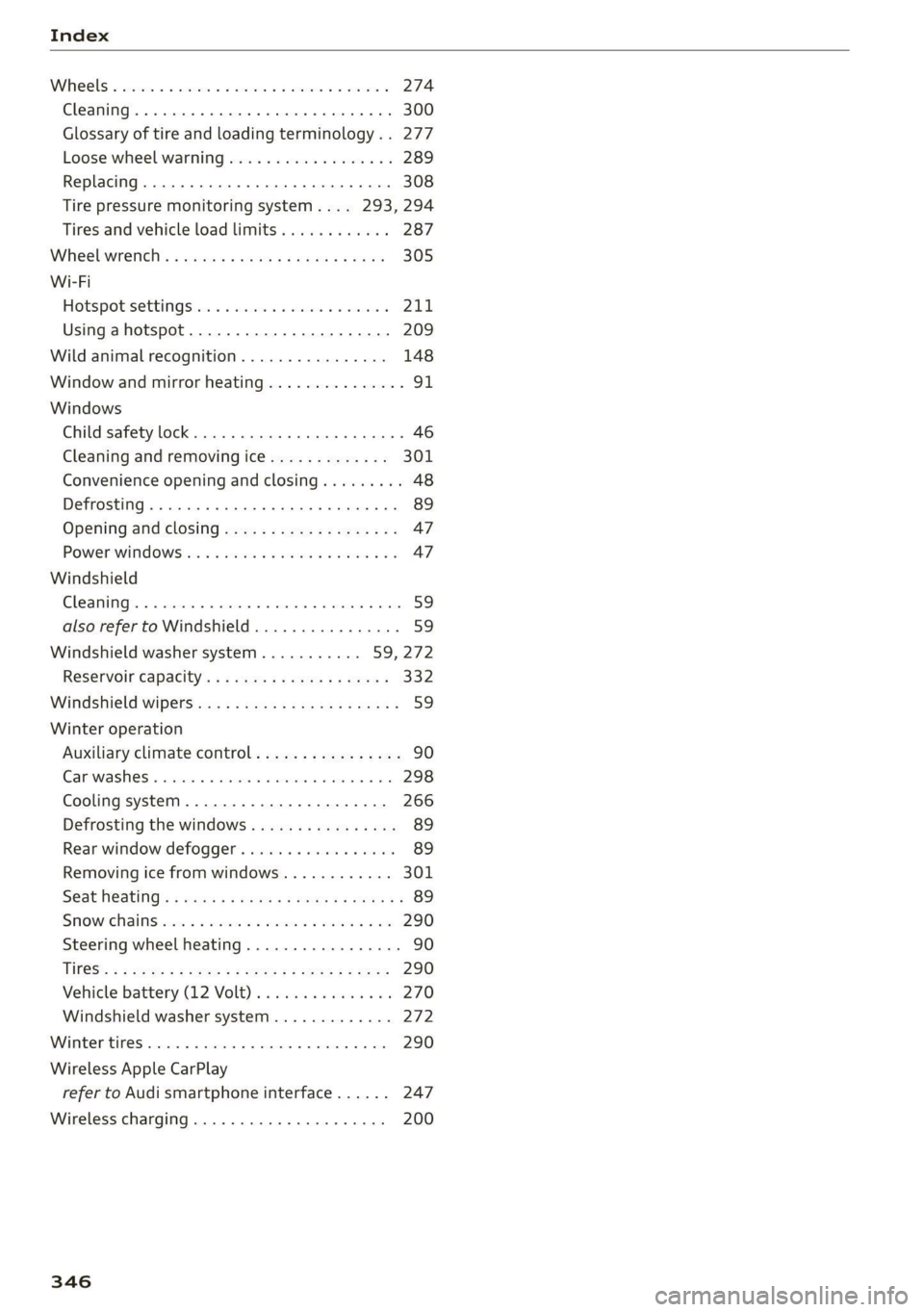
Whe els « cecncus sv sian ow cannons a o ance wo astenee 274
Cleaning 300
Glossary of tire and loading terminology .. 277
Loose wheel warning.............-.... 289
Replacing. ........ 00. c cece ee eee eee 308
Tire pressure monitoring system.... 293, 294
Tires and vehicle load limits............ 287
WhHEELWIeNGH:. + waxes 5 warm oe een x 2 eee 305
Wi-Fi
Hotspotsettingstess 5 & sass « mas 6 @ canes o 21d.
Using ahotspot.............2..20200. 209
Wild animal recognition................ 148
Window and mirror heating..............- 91
Windows
Child safety lock... 2.0.0... cee eee eee eee 46
Cleaning and removing ice............. 301
Convenience opening and closing......... 48
Defrosting....... 2... cece eee ee eee ee 89
Opening and closing................... 47
POWer WINK OWS iv: ss srenese 6 6 awinees ao oxaeew ows 47
Windshield
Cleaning. ......... cee eee eee eee 59
also refer to Windshield................ 59
Windshield washer system........... 59, 272
Reservoir Capacity’. « x cies 5 « aeem ox ema a 332
Windshield wipers ..............ceeee eee 59
Winter operation
Auxiliary climate control................ 90
Car washes « sie 2 6 scam + 0 seesaw « 4 eeu © os
Cooling system
Defrosting the windows................ 89
Rear window defogger..............005 89
Removing ice from windows............ 301
Seat Heating: « sews s + wae se wees 8 ze ers a 89
SMOWIGHAINS wines: 2s swseens x wanes vv once wa awe 290
Steering wheel heating................. 90
Tif@S:: = : seem s y ores & & oewe 5 c ems Fe eee 290
Vehicle battery (12 Volt)............00. 270
Windshield washer system............. 272
Winter tires cscs 6 « socewse 2 x anwcein sw anata 6 0 see 290
Wireless Apple CarPlay
refer to Audi smartphone interface...... 247
Wireless charging................-.05. 200
346